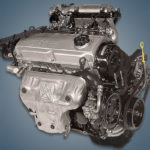1.6-liter Mitsubishi 4G18 gasoline engine was produced in Japan from 1998 to 2012, after which its assembly was transferred to China, where it is put on numerous local models.
4G18 is the largest member of the Orion 4G1 family. It was created on the same cylinder block as the 4G13 / 4G15, but this engine has a long-stroke crankshaft (stroke 87.3 mm versus 82 mm for younger models) and a piston block bore of 76 mm. Otherwise, the 4G18 is as simple a motor as other members of the 4G1 family, there are no cutting-edge systems.
The 4G1 family also includes engines: 4G13, 4G15, 4G15T and 4G19.
The engine was installed on:
- Mitsubishi Lancer 9 (CS) in 2000 – 2010;
- Mitsubishi Space Star 1 (DG) in 1998 – 2005;
- Proton Waja 1 in 2000 – 2011;
- Tagaz Aquila 1 in 2013 – 2014.
Specifications
| Production years | 1998-2012 |
| Displacement, cc | 1584 |
| Fuel system | distributed injection |
| Power output, hp | 98 – 112 |
| Torque output, Nm | 145 – 150 |
| Cylinder block | cast iron R4 |
| Block head | aluminum 16v |
| Cylinder bore, mm | 76 |
| Piston stroke, mm | 87.3 |
| Compression ratio | 9.5 – 10.0 |
| Features | SOHC |
| Hydraulic lifters | yes |
| Timing drive | belt |
| Turbocharging | no |
| Recommended engine oil | 5W-30, 5W-40 |
| Engine oil capacity, liter | 3.6 |
| Fuel type | petrol |
| Euro standards | EURO 4/5 |
| Fuel consumption, L/100 km (for Mitsubishi Lancer 2005) — city — highway — combined |
8.8 5.5 6.7 |
| Engine lifespan, km | ~300 000 |
| Weight, kg | 135 (with attachments) |
Disadvantages of the Mitsubishi 4G18 engine
- Most of the complaints of car owners with such a power unit are associated with an oil burner due to the occurrence of oil scraper rings, and it can appear by 100,000 km. The main culprit is an insufficiently effective engine cooling system.
- This motor did not pass the problem with throttle valve wear, which is branded for the series. Like other units of the Orion family, after 100,000 km, the speed begins to float due to the strong backlash of the damper. And it’s good that there are a number of alternative solutions.
- According to the manufacturer’s official regulations, the timing belt is changed at a mileage of 90,000 km, but it often breaks earlier with very sad consequences for the units. On specialized forums there are reports not only with bent valves, but also cracked pistons.
- The components of the ignition system, and especially the coils, are distinguished by a low resource, and this power unit also loves to fill in candles when starting in severe frosts. Weaknesses include not the most durable catalyst, EGR valve and engine mounts.







I have mitsubishi space star from 2003 and i have engine 4G18 and on a timing belt i have currently 124000km and i didn´t change it. Soo i don´t know if i have something else in it or it just don´t want to die.